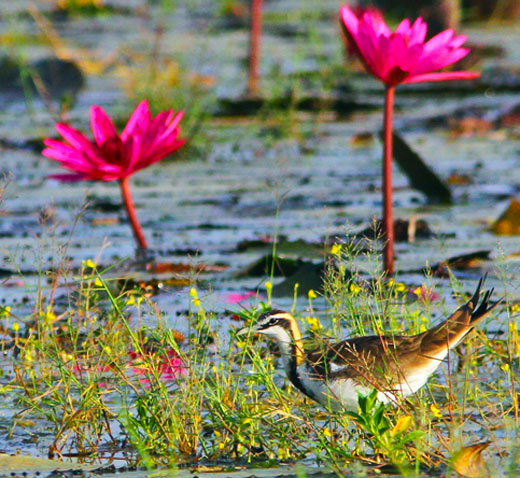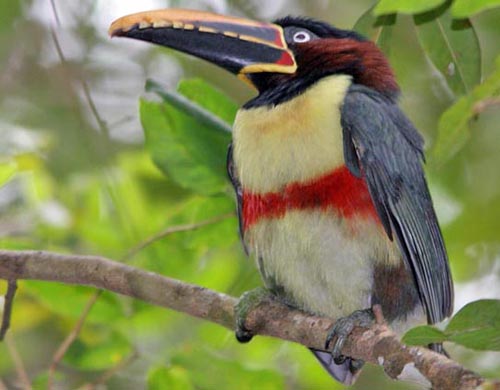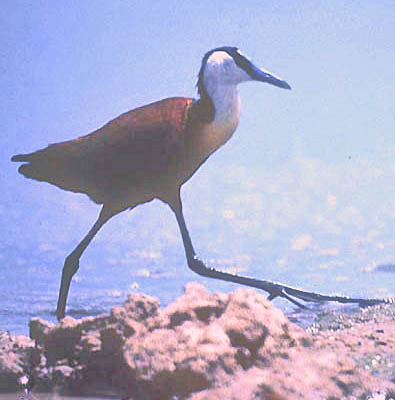
a web page by Don Roberson |
JAÇANAS Jacanidae |
||
|
||
The jaçanas have greatly elongated toes and claws that spread their weight out over a significant area, allowing them of walk on floating aquatic vegetation (those long legs, toes and claws are apparent on this Wattled Jaçana, left, of the Neotropics). Their habitat often includes lily pads, giving rise to the popular name "lily trotters" for the group. Sometimes they walk on submerged vegetation, giving the impression they are "walking on water." Their legs are also quite long, making them look rather "tall" for their relative size (Jenni 1996). The Australasian species is quite colorful and has a unique crest: Comb-crested Jaçana (below), a photo from southern New Guinea.
|
||
 |
||
Their unique features make it easy to identify a jaçana, but there is disagreement as to how many genera should be used for the eight species. Some have used many genera (e.g., Janni 1996): the two New World species (Northern & Wattled) were in Jacana, the African and Madagascar species in Actophilornis, Lesser in Microparra, Comb-crested in Irediparra, and the two Asian species in separate genera: Bronze-winged in Metopidius and Pheasant-tailed in Hydrophasianus. This is still the majority approach but a few would reduce the number of genera to two or three, with Pheasant-tailed and Lesser Jaçanas considered the most distinctive. Some populations of Pheasant-tailed are migratory and it has distinctive basic and alternate plumages. In the breeding season males have greatly elongated central rectrices but my photo (right) is a male in basic plumage, during Christmastime in Thailand. In all species, females are larger than males, producing a more extreme reversed sexual size dimorphism than any other bird or mammal species (Jenni 1996). |
||
At the time the pair of Northern Jaçana here had apparently been resident since 1967. The summer 1972 issue of American Birds says "the now-famous Manor L. Jaçanas had a successful season; late in July 3 young were seen following 1 ad., 2 following another" (AB 26:876). Our personal visit to Texas did not go unnoticed because "two Plain-tailed Brown Jays (Psilorhinus morio) were seen in woodland just below Falcon Dam, about 100 yards from the Rio Grande, on June 15 (WS)." The WS is for Wally Sumner — he was the only one of us to see the jays, which we identified from Wally's description with my Mexican field guide, and or which we searched for much of the rest of the day. These were just the second ever Brown Jays to be reported in the United States (we didn't know about an April 1969 sighting at the time) and the first to be published with the comment "the birds were well described" (yes, we did duly report the record with Wally's details; AB 26:877). Wally thus is credited for one of the very first Brown Jay records in the United States. Now, some 30+ years later, I note that Brown Jays are local residents along the Rio Grande in south Texas, but that Northern Jaçana remains a rare and difficult ABA vagrant species. |
||
I don't understand, then, why anyone would use a hard "k" sound in "jaçana." I used to say "jah-saw-naa," which is at least close to correct. In my formative birding years in the 1970s, the debate over this pronunciation was carried on in the pages of Birding magazine. To me, the most persuasive author argued the word was a South American Indian word with the emphasis of the final syllable: "haa-saa-NAA" and I've said it that way ever since. So here's now the definitive answer, from the Handbook of the Birds of the World (Janni 1996, p. 287): "The name Jacana was derived from the Portuguese transliteration of a Brazilian Indian name for the Wattled Jaçana. Although the name may be pronounced in a variety of ways, the original Portuguese spelling was Jaçaná." So there you have it: "haa-saa-NAA" it is. Yet, strangely, every time I try to educate folks on the point, I get the statement that "we'll say it any way we want. Look, there's another Jak-KAN-a." Try it yourself — use your best Texas accent and see how badly you can mangle the name of this lovely little bird. Think about a big Texas Jack-Rabbit and call it a "Jack-KAN-a." Yet if learning is acceptable to you, note the correlation between "Araçari" and "Jaçana," recall that Portuguese and Spanish names use an "h" sound for the letter "J", and add the native Brazilian uplift at the end of the word: "haa-saa-naá" or "yaa-saa-naá" (there are two variants on this, but both a lot closer to the actual word than the stuff most birders say). Pronounce it softly with that upslide at the end, and picture the girl from Ipanema as you say "yaa-saa-naá." Ahhh — a smooth name for a dramatic bird. |
||
Africa has two species of jaçana and Madagascar a third. The widespread African Jaçana (below right) is by far the one a birder is likely to encounter on an African safari. When not breeding, jaçanas tend to be social birds, occurring often in small groups. These congregations can be noisy with various thin piping calls, squeaks, and rattles. Birds move to new wetlands as favored spots disappear in the dry season — and that surely affects African Jaçana often—yet we think that most species are essentially resident. Bronze-winged Jaçana (below right) is south Asia's resident species, as Pheasant-tailed Jaçana is generally much more migratory. It has been my experience that Bronze-winged likes richly-vegetated lakes, ponds, and swamps and tends to stick to the thicker areas than some other jaçanas. It is a chunky, thick-billed species and is quite dark, making it difficult to spot at times. |
||
|
||
 |
||
The Lesser Jaçana of Africa (above) is interesting for several reasons. First, although it has a wide range in sub-Saharan Africa, it is everywhere scarce, local, and little known. It is also shy and hard to see. Second, it is the only jaçana to retain a juvenal-like plumage its entire life. Indeed, it strongly resembles a juvenal African Jaçana at a distance, being less than half the size of an adult African Jaçana. This photo is from Lake Bisini in eastern Uganda. The African Jaçanas here stood fully as tall as the purple flowers on the lily pads, while the Lesser is dwarfed by the flower. Characters separating this adult Lesser Jaçana from a baby African include the disproportionately short bill, the extensive chestnut crown, the contrast between black back and rusty shoulders and pale wing coverts, and the fact it was very eager to fly! In flight it shows a white trailing edge to the wing, lacking in African Jaçana. Lesser Jaçana is also unique in that it seems to be monogamous. All the other species have polyandrous mating systems. Males do most or all of the nest building, all incubation, and all brooding. He also does much of the care for the young, although in some species (especially Northern Jaçana) the female does quite a bit of feeding of young also. The female may consort with up to four males at a time, and it is uncertain how she decides into whose nest to lay her eggs. This is less of a dilemma when she acquires her mates sequentially (Janni 1996). All jaçanas are great fun to watch as they apparently defy physics to walking across a quiet lake or pond. They're tall and slim, and young and lovely, so just do try to say the name correctly . . . . . |
||
Photos: The Wattled Jaçana Jacana jacana was in the Brazilian Pantanal on 21 July 2010. The Comb-crested Jaçana Irediparra gallinacea was at the SDA University ponds, near Port Moresby, Papua New Guinea, on 15 Sep 2016. The Pheasant-tailed Jaçana Hydrophasianus chirurgus was at Lake Bung Boraphet, Thailand, on 29 Dec 2012 The distant shot of Northern Jaçana Jacana spinosa was at Manor Lake, Brazias Co., Texas, on 18 June 1972. The Chestnut-eared Araçari Pteroglossus castanotis was in the Brazilian Pantanal on 19 July 2010. The African Jaçana Actophilornis africanus was on the shores of Lake Jipe, Kenya, in Nov 1981. The Bronze-winged Jaçana Metopidius indicus was at t Lake Bung Boraphet, Thailand, on 29 Dec 2012. The Lesser Jaçana Microparra capensis was on lily pads on Lake Bisini, Uganda, on 30 July 2002. All photos © Don Roberson; all rights reserved. Bibliographic note: There is no specialized "family book" of which I'm aware, although this family is often covered in books that include shorebirds and allies (e.g., Hayman et al. 1986). An fine overview to the family, with a set a impressive photos, is in Jenni (1996). Literature cited:
|
 The Jacanidae are a unique family of waders, specially adapted to exploit feeding on lily pads in shallow freshwater wetlands throughout the tropics. The eight species are rather evenly distributed around the globe: two in the New World, two in Africa and one on Madagascar, two in Asia, and one primarily in Australasia.
The Jacanidae are a unique family of waders, specially adapted to exploit feeding on lily pads in shallow freshwater wetlands throughout the tropics. The eight species are rather evenly distributed around the globe: two in the New World, two in Africa and one on Madagascar, two in Asia, and one primarily in Australasia. As a group the jaçanas are distinctive, but for some time is was uncertain whether they were more closely related to rails in the Gruiformes (they have a superficial resemblance to rails) or shorebirds in the Charadriformes. Biochemical and osteological evidence shows that they are certain Charadriformes, and most closely related to the Painted-Snipes (e.g., Sibley & Monroe 1990).
As a group the jaçanas are distinctive, but for some time is was uncertain whether they were more closely related to rails in the Gruiformes (they have a superficial resemblance to rails) or shorebirds in the Charadriformes. Biochemical and osteological evidence shows that they are certain Charadriformes, and most closely related to the Painted-Snipes (e.g., Sibley & Monroe 1990). Although New World jaçanas are typically resident species, the first photo I ever took of any vagrant was this Northern Jaçana in south Texas (left). It was June 1972 and the month-long trip to Arizona and Texas with Wally Sumner and Ken Knittle was my first birding trip of any significant distance. We heard that a jaçana had been at Manor Lake and so went to look for it — not because it was a vagrant, but because it was a lifer, just like the Carolina Chickadees and Mottled Ducks along the Gulf coast. I did not have a telephoto lens; this is just a basic 35mm lens scenic of the lake with the jaçana emerging from the vegetation in the distance at left center.
Although New World jaçanas are typically resident species, the first photo I ever took of any vagrant was this Northern Jaçana in south Texas (left). It was June 1972 and the month-long trip to Arizona and Texas with Wally Sumner and Ken Knittle was my first birding trip of any significant distance. We heard that a jaçana had been at Manor Lake and so went to look for it — not because it was a vagrant, but because it was a lifer, just like the Carolina Chickadees and Mottled Ducks along the Gulf coast. I did not have a telephoto lens; this is just a basic 35mm lens scenic of the lake with the jaçana emerging from the vegetation in the distance at left center.  The pronunciation of the name "Jaçana" has also been the subject of debate. Most birdwatchers flipping through a field guide say "Jaw-KAW-naa" but when I first started birding, it was obvious that such pronunciation was wrong. This was because older bird books and older field guides quite properly printed a cedilla under the "c" means that the "c" sound is soft and sibilant (like "s") and not hard (like "k"), to wit: Jaçana. This indicates the word is Portuguese. The other formal bird name that is Portuguese — with a cedilla — is a set of small toucans called Araçari. Here (right) is a Chestnut-eared Araçari from Brazil. I've never run into an English-speaking birder who had any difficulty is saying "Araçari" correctly ["Are-aaw-sorry"].
The pronunciation of the name "Jaçana" has also been the subject of debate. Most birdwatchers flipping through a field guide say "Jaw-KAW-naa" but when I first started birding, it was obvious that such pronunciation was wrong. This was because older bird books and older field guides quite properly printed a cedilla under the "c" means that the "c" sound is soft and sibilant (like "s") and not hard (like "k"), to wit: Jaçana. This indicates the word is Portuguese. The other formal bird name that is Portuguese — with a cedilla — is a set of small toucans called Araçari. Here (right) is a Chestnut-eared Araçari from Brazil. I've never run into an English-speaking birder who had any difficulty is saying "Araçari" correctly ["Are-aaw-sorry"].
